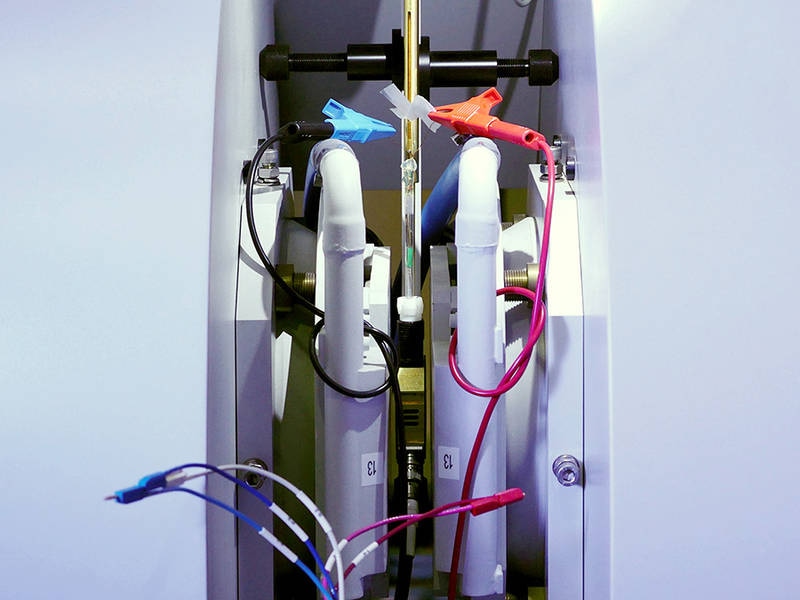Dec 7 2017
Metallic lithium tends to get deposited on the anodes when lithium-ion batteries are charged very rapidly. This lowers battery capacity and lifespan and can even damage the batteries. Researchers at the Technical University of Munich (TUM) and the Forschungszentrum Jülich have currently demonstrated a process that, for the first time ever, allows this lithium plating process to be examined directly. This opens doors for new approaches in quick-charging strategies.
 ESR-spectroscope (Photo: Tobias Schlößer / FZ Jülich)
ESR-spectroscope (Photo: Tobias Schlößer / FZ Jülich)
Lithium plating, which is the depositing of metallic lithium at the anodes of lithium-ion batteries, is one of the major factors that hinder charging current. The battery performance suffers considerably from these metallic deposits. In rare cases, this can cause short circuits and even batteries bursting into flames.
When batteries are being charged, the positively charged lithium ions travel through the liquid electrolytes and get deposited in the porous graphite anodes. However, the larger the current and the lower the temperature, the bigger the likelihood that the lithium ions will not be deposited within the electrodes, as anticipated, but instead as a solid metallic layer on the outer surface.
Indirect Evidence Does Not Serve the Goal
Even though this occurrence is mostly well-known, many aspects still are unclear. Thus far, it was not possible to directly view how and under which conditions lithium plating took place.
Using traditional methods of microscopy, we can only observe a battery after the fact, because it needs to be cut open. In the process, further reactions that distort the results become inevitable.
Dr. Josef Granwehr, The Jülich Institute of Energy and Climate Research (IEK-9)
Even extremely developed processes like neutron scattering permit only indirect analyzes. Complicating the issue is the fact that available slots for measurements at research reactors and large particle accelerators are limited. This makes these tools more appropriate for vital investigations than for monotonous, practical test series.
Electrons Show the Way
The electron paramagnetic resonance (EPR) spectroscopy process described in the well-known scientific journal Materials Today, on the other hand, can be readily incorporated into laboratory procedures – with only minimal investment. The technique is analogous to the better-known nuclear magnetic resonance (NMR) spectroscopy, albeit focuses on electron spins instead of an atomic nuclei.
“Electrons are placed in an externally applied, static magnetic field,” explains Granwehr.
Microwaves are used to “sound out” unpaired electrons in the sample. In the magnetic field, these trigger the electrons to flip, which can be measured via the related drop in microwave radiation intensity. EPR can distinguish between lithium embedded in the graphite anodes and metallic lithium plating.
The Test Cell Is the Key
The key to detecting lithium plating using EPR was the construction of a test cell compatible with the requirements of EPR spectroscopy while at the same time exhibiting good electrochemical properties. The geometry is also important. Precise measurement results are contingent on the sample being exposed to the magnetic field but not the inevitably present electric field.
Dr. Johannes Wandt, Lead Author
To guarantee this, Wandt created a rod-shaped cell while he was a doctoral candidate in the group of Prof. Hubert A. Gasteiger, Chair of Technical Electrochemistry at TUM, that allows the development of metallic lithium to be detected directly and with quantitative exactness.
The Right Strategy for Quick Charging
Using this process, it is now for the first time possible to investigate lithium plating and the associated processes in a differentiated manner that is relevant to a whole array of applications. One example is the development of safe and at the same time fast charging protocols. Our process make determining the maximum charging current before lithium plating sets in possible, as well as ascertaining other boundary conditions like temperature and the influence of electrode geometry.
Rüdiger-A. Eichel, Director, The Jülich Institute of Energy and Climate Research
Beyond this, the methodology is perfect as a test procedure for a range of battery materials, for instance the development of new admixtures that overpower lithium plating.
The research received funding from the German Federal Ministry of Education and Research (BMBF) in the context of the ExZellTUM II project and the Bavarian State Ministry of Economic Affairs and Media, Energy and Technology in the context of the EEBatt project. The EEBatt project is part of the “TUM.Energy” priority program organized by the Munich School of Engineering (MSE).